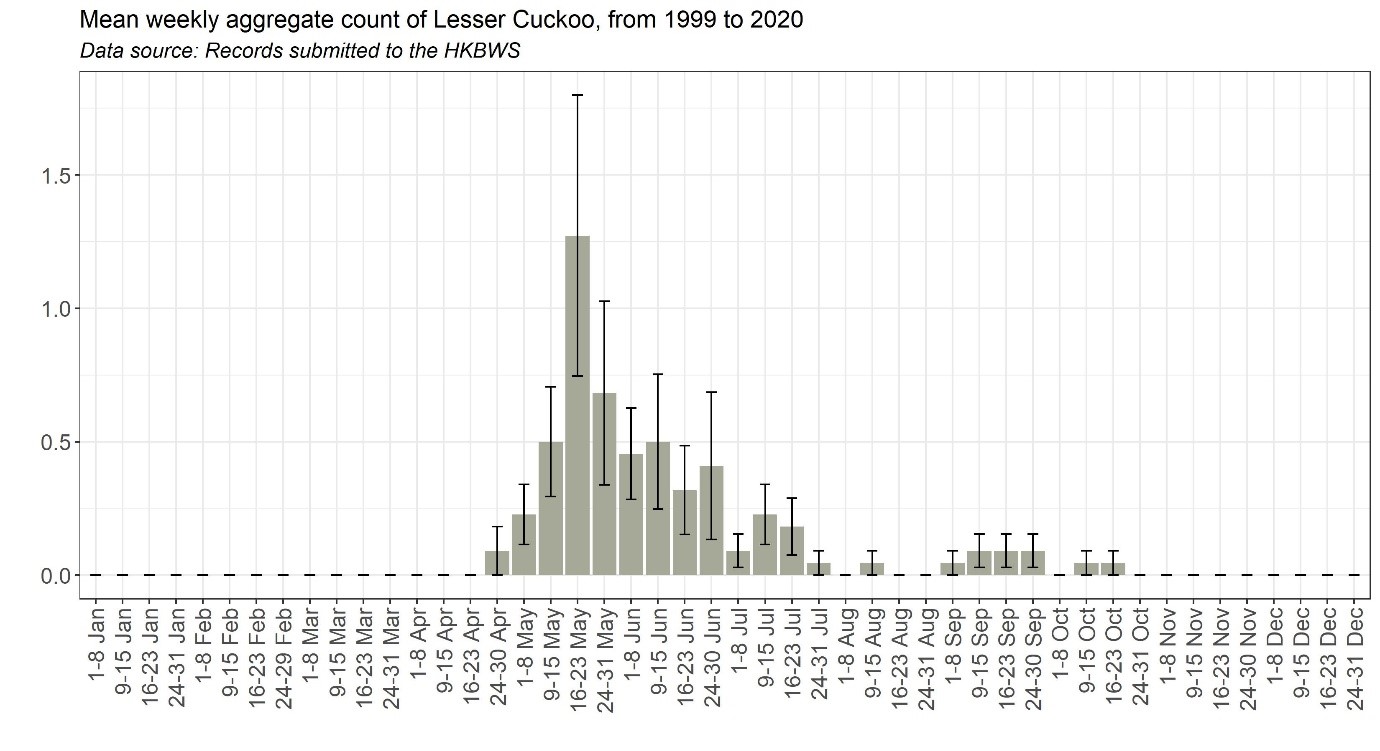Lesser Cuckoo Cuculus poliocephalus 小杜鵑
Category I. Uncommon summer visitor and scarce passage migrant that has greatly increased since the 1990s.
IDENTIFICATION

Jun. 2019, Michelle and Peter Wong.
38-40 cm Relatively small, slender-bodied and fine-billed, with a yellow eye-ring and brown iris. Grey-morph adults are very similar in plumage to congeners in southeast China but show somewhat sparser, more widely-spaced and incomplete blackish barring on the lower chest and belly, and plain buff undertail coverts. Hepatic females are usually unbarred on the head and rump.

Sep. 2006, Michelle and Peter Wong.
The grey morph juvenile has grey upperpart feathers narrowly fringed pale, wing coverts and flight feathers notched pale, greyish head and throat and boldly-barred undertail. The juvenile hepatic morph is barred brown and black above and brown and buff below. Juveniles are darker above and on throat than Oriental Cuckoo (Erritzøe et al. 2012).
VOCALISATIONS
The song is a jaunty if somewhat staccato series of short phrases, the first of which may be slightly higher in pitch, shorter and faster-paced than the remainder. The first two notes in each phrase are usually somewhat shorter, higher in pitch and separate from the remainder. The pace and pitch of phrases appears to vary among birds, while individual birds toward the end of series may utter phrases that are lower and more even in pitch.
DISTRIBUTION & HABITAT PREFERENCE
Lesser Cuckoo occurs at all altitudes in fairly widespread parts of the central and northeast New Territories, especially around the Tai Mo Shan massif and in the Pat Sin Leng hills, and occasionally elsewhere, including Mai Po and Po Toi. Breeding season birds show a strong preference for areas of forest and closed-canopy shrubland and are also occasionally found in stands of trees or small woods on the edge of open areas such as fishponds. Nearly all sightings of autumn migrants are in fung shui woodland on Po Toi.
OCCURRENCE
Lesser Cuckoo has been recorded from 24 April to 20 October (Figure 1). It occurs predominantly as a summer visitor, with almost all records up to 28 July referring to birds vocalising in forest or mixed shrubland. Occasional autumn migrants, all visually detected, have been noted in September and October, and the only record in August concerns a juvenile at Shek Kong Catchwater on 14 August 2018 which may have been locally bred. Of 120 birds recorded in the years 1999-2020, over 80% occurred in May or June. Most records are of single birds, occasionally two, with the highest count being three on Tai Mo Shan on 9 June 2016.
The first four HK records were in autumn from 28 September to 14 October (Leven 1998), and the first breeding season records involved singing birds in late May and late June 2008 and 2011. Subsequently, following an increase in 2014 when there were records from six sites, a sharp rise in the number of records and number of sites occurred, with 80% of all records thus far occurring from 2015 to 2020. The increase is considered due to an increase in numbers of a favoured host species, possibly Brown-flanked Bush Warbler.
BREEDING
Though strongly suspected, breeding is not confirmed.
BEHAVIOUR, FORAGING & DIET
Adults sing from within a tree or in flight both by day and night but are otherwise extremely secretive in habits.
RANGE & SYSTEMATICS
Monotypic. Breeds from Afghanistan, north Pakistan and Kashmir along the Himalayas east to southeast Tibet, north Indochina and east through much of China to Ussuriland, Korea and Japan, and winters to India and E Africa (Payne 1997, Robson 2008). In China, it is absent from the extreme northwest but occurs as a summer visitor in all other parts, excluding Hainan where it is now known to be a rare passage migrant (Lewthwaite et al. 2021).
CONSERVATION STATUS
IUCN: Least Concern. Population trend stable.
Figure 1.

Cheng, T. H. (1987). A Synopsis of the Avifauna of China. Science Press, Beijing.
Erritzøe, J., C. F. Mann, F. P. Brammer and R. A. Fuller (2012). Cuckoos of the World. Christopher Helm, London.
Leven, M. R. (1998). Asian Lesser Cuckoo: the first record for Hong Kong. Hong Kong Bird Report 1996: 118-124.
Lewthwaite, R. W., Li, F. and Chan, B. P. L. (2021). Online Supplement to “An annotated checklist of the birds of Hainan Island, China”. Available at https://www.kfbg.org/images/download/hainan-bird-checklist-supplement.pdf.
Payne, R. B. (1997). Family Cuculidae (Cuckoos) in del Hoyo, J., Elliot, A. and J. Sargatal. Handbook of the Birds of the World, vol. 4: Sandgrouse to Cuckoos. Lynx Edicions, Barcelona, Spain.
Robson, C. (2008). A Field Guide to the Birds of South-East Asia. New Holland, London.

